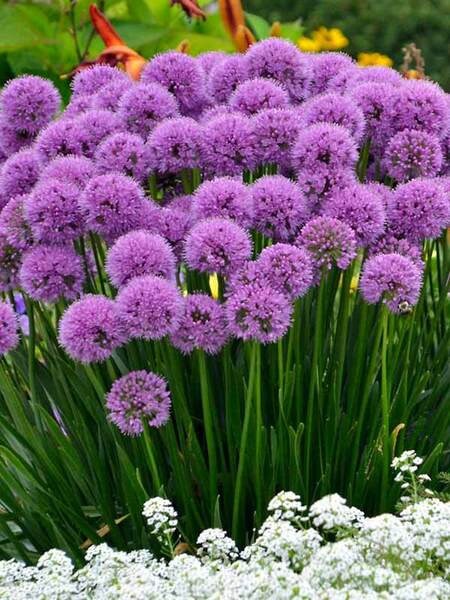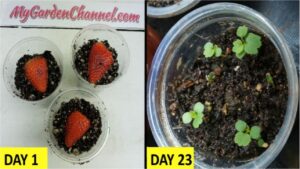Purple alliums are striking ornamental plants known for their large, globe-shaped flower heads made up of hundreds of tiny star-shaped blooms. These bold and architectural flowers are a favorite among gardeners for their stunning appearance, drought tolerance, and ability to attract pollinators. Alliums belong to the same family as onions, garlic, and leeks (Alliaceae), but they’re grown for their ornamental qualities rather than culinary use. With proper care, purple alliums can return year after year to add dramatic flair to your garden.
In this comprehensive guide, we’ll cover everything you need to know about growing and caring for purple allium bulbs, from planting to post-bloom maintenance.
1. Understanding Purple Alliums
Purple alliums are typically grown from bulbs and bloom in late spring to early summer. Some of the most popular varieties include:
- Allium giganteum: One of the tallest alliums, with large violet-purple blooms up to 6 inches wide.
- Allium ‘Purple Sensation’: A mid-sized favorite with deep purple flowers and excellent structural form.
- Allium aflatunense: Known for its dense spherical blooms, often mistaken for ‘Purple Sensation.’
These varieties range in height from 18 inches to over 4 feet, depending on the type. They make excellent focal points in perennial beds and pair beautifully with plants like catmint, salvia, and ornamental grasses.
2. When and Where to Plant Allium Bulbs
When to Plant
- Best time: Fall, typically from September to November, before the first hard frost.
- Why fall? Bulbs need a cold dormancy period to trigger spring blooming.
Where to Plant
- Sunlight: Alliums love full sun. Aim for at least 6 hours of direct sunlight per day.
- Soil: Well-draining soil is crucial. Avoid areas that stay wet, as bulbs are prone to rot.
- Spacing: Plant bulbs 4–8 inches apart, depending on the variety. Give larger varieties more space.
Companion Plants
Alliums mix well with:
- Roses
- Peonies
- Daylilies
- Hostas (for shade-tolerant varieties)
- Ornamental grasses
Plant them in groups or drifts for the most dramatic effect.
3. How to Plant Purple Allium Bulbs
Step-by-Step Planting Instructions
- Prepare the soil
Loosen the soil to a depth of 12 inches. Mix in compost or aged manure to improve drainage and fertility. - Dig planting holes
- For large alliums: 6–8 inches deep
- For smaller varieties: 4–6 inches deep
- Place the bulb
Pointy side up, roots down. If you’re unsure, place it on its side—it will correct itself. - Backfill and water
Fill the hole with soil and water thoroughly. This encourages root growth before the ground freezes. - Mulch (optional)
Apply a thin layer of mulch to conserve moisture and reduce temperature fluctuations.
4. Growing and Caring for Alliums
Watering
- Fall: Water after planting to settle soil. Don’t overwater.
- Spring: Water moderately, especially during dry spells.
- Avoid soggy soil: Overwatering is the number one killer of allium bulbs.
Fertilizing
- Fall (optional): Mix in slow-release bulb fertilizer during planting.
- Spring: Apply a balanced fertilizer (e.g., 10-10-10) when shoots emerge.
- Avoid over-fertilizing: Too much nitrogen can lead to lush leaves at the expense of flowers.
Staking
- Taller varieties (like Allium giganteum) may need support in windy areas. Use discreet bamboo stakes or plant among sturdy perennials for natural support.
Pest and Disease Resistance
- Generally pest-free
- Deer and rodent resistant: Their onion-like smell deters most critters.
- Common issues:
- Bulb rot: Avoid overwatering and poor drainage.
- Downy mildew: Space plants to promote airflow.
5. Blooming and Aftercare
Flowering Season
- Most purple alliums bloom from late spring to early summer (May–June).
- Flowers last 3–4 weeks and attract bees, butterflies, and other pollinators.
Deadheading
- Once flowers fade, you can:
- Remove the spent blooms to keep the garden tidy.
- Leave seed heads for visual interest—they look beautiful dried or frosted in winter.
Foliage Care
- Allow foliage to die back naturally. This helps bulbs store energy for next year.
- Do not cut leaves until they are completely yellow and dry.
- If the fading leaves are unsightly, camouflage them with surrounding plants.
6. Dividing and Propagating
When to Divide Allium Bulbs
- Every 3–4 years, if flower production declines or clumps become overcrowded.
How to Divide
- Wait until late summer or early fall.
- Carefully dig up the clump.
- Separate the bulbs.
- Replant the healthiest ones immediately in a new or improved spot.
Propagation Tips
- Some varieties will self-seed, though seedlings may take 2–3 years to bloom.
- You can collect seeds from mature seed heads, but this is a slow process compared to bulb division.
7. Overwintering Alliums
- Alliums are hardy in USDA zones 4–9, depending on the variety.
- In colder regions (zones 3 and below), apply a thicker mulch layer after the ground freezes.
- In milder zones, alliums typically survive winter without protection.
Container-grown alliums should be moved to an unheated garage or protected location during hard freezes, as containers expose bulbs to more extreme cold.
8. Growing Alliums in Containers
- Choose a deep container (at least 10 inches) with good drainage.
- Use a gritty, well-draining soil mix (e.g., cactus mix blended with compost).
- Water sparingly and protect from extreme cold.
- Group multiple bulbs in a pot for a full, lush bloom.
9. Common Problems and Troubleshooting
| Problem | Cause | Solution |
|---|---|---|
| Bulbs not blooming | Overcrowded, insufficient sun, poor soil | Divide and replant, ensure full sun, improve drainage |
| Yellowing leaves too early | Underwatering or fungal disease | Water more consistently, check for rot |
| Mushy or rotting bulbs | Overwatering or poor drainage | Plant in raised beds or amend soil |
| Weak flower stalks | Too much nitrogen or not enough sun | Use balanced fertilizer, relocate to sunnier spot |
| No re-bloom next year | Cut foliage too early | Always allow leaves to die back naturally |
10. Design Tips and Final Thoughts
- Mass plantings: Group bulbs in clusters of 5–10 for greater impact.
- Stagger bloom times: Combine early-, mid-, and late-blooming varieties.
- Cut flowers: Alliums are excellent in fresh and dried arrangements. Cut when blooms are just opening.
- Naturalizing: Some species, like Allium sphaerocephalon, will naturalize and spread over time.
Conclusion
Purple alliums are low-maintenance, long-lasting, and visually stunning additions to any garden. With the right care—well-drained soil, full sun, and thoughtful seasonal maintenance—these eye-catching blooms will return year after year. Whether you’re filling a formal border, creating a pollinator haven, or adding architectural flair to your flower beds, alliums offer versatility and bold beauty with minimal fuss.
Happy planting!


